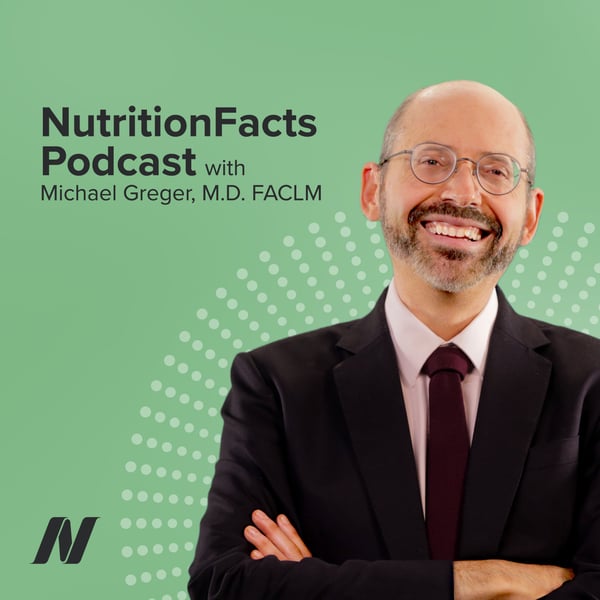There’s a Fungus Among Us
Nutrition Facts with Dr. Greger
[email protected]
4.8 • 3.6K Ratings
🗓️ 13 January 2022
⏱️ 9 minutes
🧾️ Download transcript
Summary
This episode features audio from Ochratoxin in Breakfast Cereals and Ochratoxin in Certain Herbs, Spices, and Wine. Visit the video pages for all sources and doctor's notes related to this podcast.
Transcript
Click on a timestamp to play from that location
| 0:00.0 | Let's say you're trying to lose 20 pounds or boost your immunity or increase your ability to fight COVID or even cancer. |
| 0:08.0 | Well, the amazing thing is with the right diet, you are well in your way to achieving these vital health goals. |
| 0:15.0 | Welcome to the Nutrition Facts Podcast. I'm your host, Dr. Michael Greger. |
| 0:21.0 | Today, we have the first four-part series on molds that show up in our food. They produce mycotoxins and we'll find out which foods contain them and how concerned we should be about ingesting them. |
| 0:35.0 | And we'll start with breakfast cereals. |
| 0:38.0 | In France, exposure to dietary contaminants was compared between vegetarians and meat eaters, and the results showed that exposures to persistent organic pollutants like PCBs and dioxins was dramatically lower among those eating more plant-based due to the non-consumption of foods of animal origins. |
| 0:57.0 | Though they did have higher estimated exposure to some mycotoxins, fungal toxins present in moldy food. Now, there are lots of types of mold on the planet and the vast majority are harmless. |
| 1:09.0 | But for the last several years, certain mold toxins, such as aflatoxin and ochre toxin, have been popping up in breakfast cereals. |
| 1:17.0 | Hundreds of samples were taken off store shelves, and about half were contaminated with ochre toxin, for example. But those were store shelves in Pakistan, and Pakistan has a subtropical climate with monsoons and flash floods leading to fungal propagation. |
| 1:32.0 | But then, similar results have popped up in Europe, Serbia, Spain, Portugal. Then, mycotoxins were discovered in breakfast cereals in Canada. |
| 1:44.0 | What about breakfast cereals in the United States? 144 samples were collected, and similar to other countries about half were found to contain ochre toxin, but only about 7% exceeded the maximum limit established by the European Commission. |
| 1:59.0 | What is the significance of the finding of ochre toxin in breakfast cereals from the United States? This was the largest study to date, including nearly 500 samples of cereal off-store shelves across the US. |
| 2:11.0 | Overall, detection rates were about 40%, and although only 16 violated the European standards, all of the cereals with ochre toxin were oat-based, making about 113 of the oat-based breakfast cereal samples tested being contaminated. |
| 2:26.0 | Ochre toxin has become increasingly regulated by many countries to minimize chronic exposure. Some countries are very strict, like in the European Union. |
| 2:36.0 | Other countries, less so, and one country in particular has no standards at all. Ochre toxin is not currently regulated at all in the United States. |
| 2:47.0 | What if you stick to organic products? One might expect them to actually be worse, owing to the fact that fungicides are not allowed in organic production. |
| 2:55.0 | However, micotoxin concentrations are usually similar or even reduced in organic compared to conventional products. For example, one of the breakfast cereal studies, research has found similar contamination, and the same was found for infant foods. |
| 3:08.0 | It cannot be concluded that one is better than the other from a micotoxin perspective, despite no use of fungicides, organic systems appear generally able to maintain micotoxin contamination at low levels. |
| 3:21.0 | But how much is that saying, given how widespread it is, how concerned should we be about the public health effects from long-term exposure of this potent micotoxin? |
| 3:31.0 | I mean, if you look at blood samples taken from populations going back decades, sometimes 100% of people turn up positive for ochre toxin circulating in their bloodstream. |
| 3:40.0 | In some sense, they are unavoidable contaminants of food since the detection of micotoxins is not only easy and they can remain hidden, and once foods have become contaminated, micotoxins aren't destroyed by cooking, so whether some foods we should simply try to avoid due to high risk of contamination, that's exactly the question I'm going to address. |
| 4:00.0 | Oats can be thought of as uniquely nutritious, and one root thing, improve human health by providing prebiotics to increase the growth of beneficial gut microbiota. |
... |
Please login to see the full transcript.
Disclaimer: The podcast and artwork embedded on this page are from [email protected], and are the property of its owner and not affiliated with or endorsed by Tapesearch.
Generated transcripts are the property of [email protected] and are distributed freely under the Fair Use doctrine. Transcripts generated by Tapesearch are not guaranteed to be accurate.
Copyright © Tapesearch 2025.

